Rosewill Armor EVO Case Review: Sometimes Performance Isn't Everything
by Dustin Sklavos on January 23, 2013 12:01 AM EST- Posted in
- Cases/Cooling/PSUs
- Rosewill
- ATX
- E-ATX
Noise and Thermal Testing, Overclocked
Since Rosewill's Armor EVO is obviously more than a match for the stock testbed, overclocked and overvolted components would seem to be the order of the day. Again, though, expect pretty much the same results as before: a case that runs cooler than Antec's class leading Eleven Hundred, but also runs louder in the process. We're talking about two 120mm fans and a 230mm fan pulling intake duty and three 120mm fans handling exhaust. The 230mm fan, in particular, is blowing directly on to the GPU.
Ambient temperature remains roughly the same at ~21C.
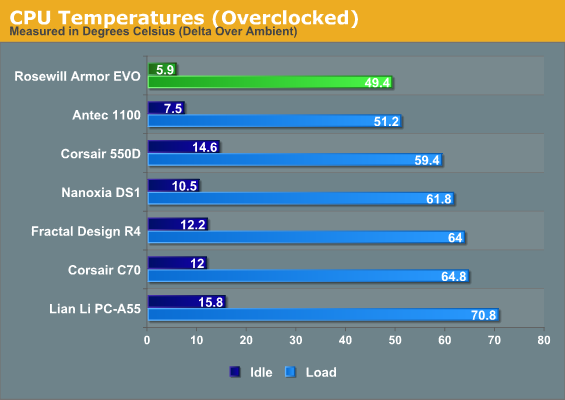
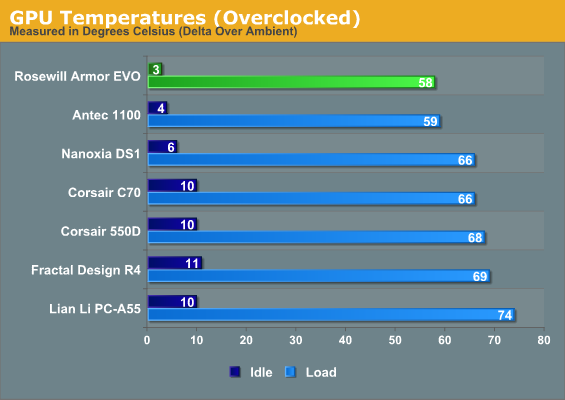
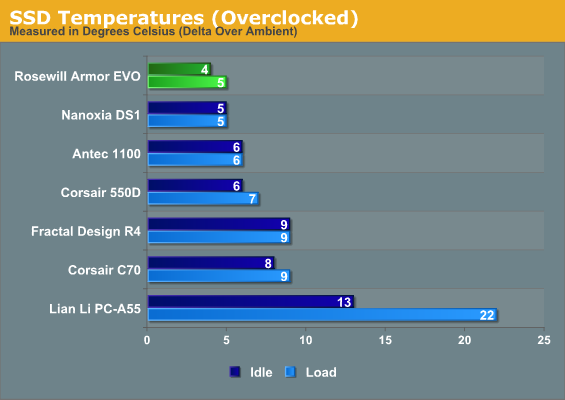
The Armor EVO's thermal performance continues to be pretty tough to beat. You'd really have to go past the $150 price point to find cases that can compete with it (outside of the Eleven Hundred), and even then you're talking about performance roughly on par with lower noise levels.
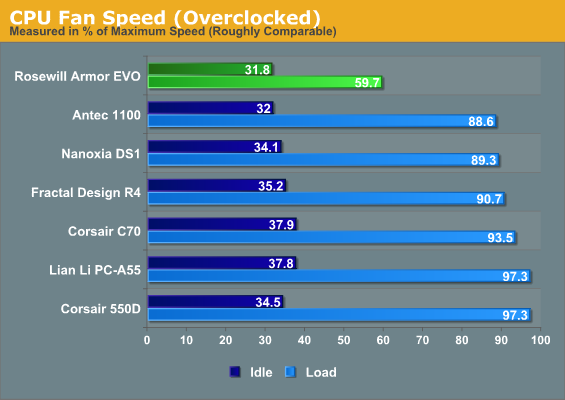
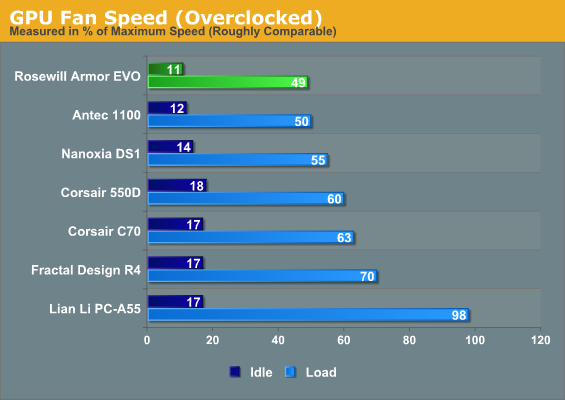
The astonishingly low temperatures of the CPU cores keep the CPU fan from having to ever reach its inflection point, where it starts having to go full bore. GPU fan speed is also ridiculously low.
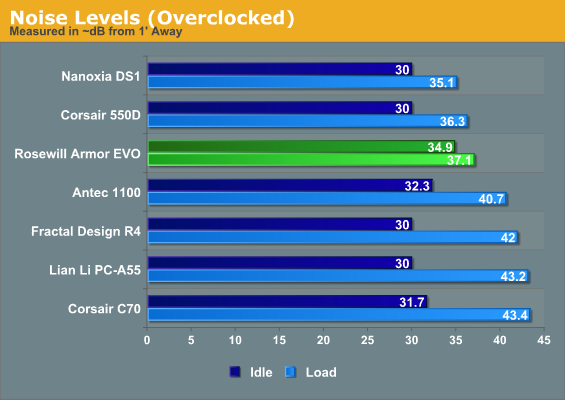
Idle noise on the Armor EVO is a bitter pill, but the stellar airflow keeps load noise from being too much of a menace, and it sweeps the Eleven Hundred. The Armor EVO does such a good job of keeping the components cool that the heatsink fans just never have to spin up that far.










19 Comments
View All Comments
max347 - Wednesday, January 23, 2013 - link
Second paragraph, second sentence, seen->see*?SunLord - Wednesday, January 23, 2013 - link
You know what I would like to see in case reviews photos of the case with different size motherboards. I don't care about them testing the case with all the different sizes but it would be nice to see what a Full ATX and an E-ATX would look like installed in the cases that support them using a MicroATX MB is nice for a constant variable in testing across all cases but gives you zero clue on how well a motherboard you would actually use in this case would fit or lookSabresiberian - Wednesday, January 23, 2013 - link
I agree here. I understand the reson to stick with one size mainboard for all testing, but I'm very skeptical of the clams of some of these case manufacturers when they say their case will hold "XL-ATX" and "E-ATX". Get one of those EVGA SR-2s and slap that baby in there, heh.Sabresiberian - Wednesday, January 23, 2013 - link
reason*; claims*. Sheesh, my error checker was way on the blink on this post.Barbarossa - Monday, January 28, 2013 - link
The SR-2 is HPTX, most cases don't claim compatibility with that.By E-ATX most people mean a Rampage or Maximus board from Asus or similar, which isn't actually the same as the TRUE E-ATX spec.
XL-ATX is kind of a made-up spec, but it was used to define longer than standard boards (more than 8 slots).
ForeverAlone - Wednesday, January 23, 2013 - link
It's nice to see that twin-120mm fans on the front are standard now.number58 - Wednesday, January 23, 2013 - link
I noticed that the numbers from the recently reviewed phantom 630 were not in the tables to compare with this case. Any particular reason?vol7ron - Wednesday, January 23, 2013 - link
Not sure this would have much of an impact on results, but do you take ambient temperature before/during (maybe even after) tests?pensive69 - Wednesday, January 23, 2013 - link
how about a marriage between a small home or dorm room fridge maker and a case maker? you'd be able to do your install INSIDE an actual fridge with insulation and temp controls provided in a system designed to work at 35 - 45 F anyway?ambient air solutions start around 30 - 40 F higher out of the box
Beenthere - Wednesday, January 23, 2013 - link
Some of the PC case makers seem to have lost the plot...There is a reason why the original tower PC cases were built the way they were with no openings in the top of the case. Here's a hint: what blows out can also fall in...
While in theory an open top allows warm air to escape easily, it also allows dirt/dust/liquids/small objects, etc. to enter - even when unintended or unwanted. Thus top openings in PC cases are a bad idea on several fronts including NOISE, for those who don't already know.
As far as buying this Rosewill case based on it's "thermal headroom", that is a sick joke. It hardly matters if your OC'd CPU runs at 49C or 51C as either is well within the low end of the operating range for ANY CPU. Hell 59C isn't even an issue.
With all of the disadvantages to this case design be it the top opening, which being raised is REALLY bad, the noise, the shoddy construction, the excessive fan noise, the screened side panel and the excessive price, this unit can hardly be recommended for anyone with a clue. Yes some folks will buy it for it's "stealthy" look or it's pretty LEDs but not anyone with a clue, especially when you can buy a quality conventional PC casr for ~$70.
It's actually quite silly what the PC case market has become in recent years to entice the 13 year old kids. I'm surprised they aren't selling PC cases with tit and arse plastered on the outside of them - aka Lara Croft/Anjie Jolie, like they do GPU cards. Those would fly out the door faster than they could produce them. The 13 year old kids could have their favorite fantasy babe half naked sprawling all over the outside of their PC case. Oh baby, I can't wait for these...soon to be on shelves no doubt. :(